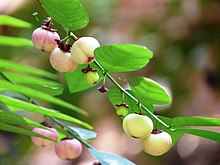Breynia androgyna, also known as katuk, star gooseberry, or sweet leaf, is a shrub grown in some tropical regions as a leaf vegetable.
This article needs additional citations for verification. (January 2024) |
| Breynia androgyna | |
|---|---|
 | |
| Scientific classification | |
| Kingdom: | Plantae |
| Clade: | Tracheophytes |
| Clade: | Angiosperms |
| Clade: | Eudicots |
| Clade: | Rosids |
| Order: | Malpighiales |
| Family: | Phyllanthaceae |
| Genus: | Breynia |
| Species: | B. androgyna |
| Binomial name | |
| Breynia androgyna (L.) Chakrab. & N.P.Balakr. (2012) | |
| Synonyms[2][3] | |
|
List
| |
Its multiple upright stems can reach 2.5 meters high and bear dark green oval leaves 5–6 cm long.
It is native to India and Bangladesh, Indochina, southern China including Hainan, Malesia, and New Guinea.[2] It inhabits tropical and subtropical humid lowland forest, where it grows on brushy slopes and sunny forest margins from 100 to 400 meters elevation.[1] It is cultivated up to 1,300 m.[4][full citation needed]
It is a good source of vitamin K.[citation needed] and contains high level of provitamin A carotenoids, especially in freshly picked leaves, as well as high levels of vitamins B and C, protein and minerals. The more the leaves mature, the higher the nutrient content of the leaves.[5]
However, a study has suggested that excessive consumption of uncooked and juiced katuk leaves (due to its popularity for body weight control in Taiwan in the mid 1990s) can cause lung damage, due to its high concentrations of the alkaloid papaverine.[6]
Cultural usage
It is one of the most popular leafy vegetables in South and Southeast Asia and is notable for high yields and palatability.[7] It can be cultivated specifically for edible asparagus stems using heavy fertilization, this cultivation variant is known as "Sabah vegetable." The stems are otherwise not edible.[8]
Indonesia
In Indonesia, the flowers, leaves, and small purplish fruits of Breynia androgyna has been consumed and used traditionally since ancient times by the Javanese and Sundanese ethnic groups as the alternative medicine in a form of Jamu (traditional concoction native to Java island, originally formulated by the Javanese) to improve the circulation of blocked breast milk for breastfeeding mothers.[9] Interestingly, according to modern research findings on the efficacy of this herb, indicates that the extract of the Breynia androgyna leaf increases the expression of prolactin and oxytocin genes 15 to 25 times in breastfeeding mice.[10]
Malaysia
In Malaysia, it is commonly stir-fried with egg or dried anchovies.
Vietnam
In Vietnam, the shoot tips have been sold in cuisine and used similarly like the asparagus; the locals usually cook it with crab meat, minced pork or dried shrimp to make a soup.
Medical
Various studies have confirmed that Breynia androgyna has notable phytochemical constituents and various pharmacological activities including antioxidant, anti-inflammatory, and anti-obesity activities.[11]
However, although the exact cause is unknown, consumption of large quantities of uncooked Breynia androgyna leaves or raw juice has been reported as being associated with bronchiolitis obliterans, leading to lung failure.[12][13][14]
Nutrition
Breynia androgyna is a good source of provitamin A carotenoids, and vitamin C and vitamin B.[5]
| Nutritional value per 100 g (3.5 oz) | |||||||||||||||||||||||||
|---|---|---|---|---|---|---|---|---|---|---|---|---|---|---|---|---|---|---|---|---|---|---|---|---|---|
| Energy | 245 kJ (59 kcal) | ||||||||||||||||||||||||
11 g | |||||||||||||||||||||||||
1 g | |||||||||||||||||||||||||
4.8 g | |||||||||||||||||||||||||
| |||||||||||||||||||||||||
| Other constituents | Quantity | ||||||||||||||||||||||||
| Water | 91.4 g | ||||||||||||||||||||||||
| †Percentages estimated using US recommendations for adults,[15] except for potassium, which is estimated based on expert recommendation from the National Academies.[16] | |||||||||||||||||||||||||
- Leaves and fruits of Breynia androgyna
- Breynia androgyna
Vernacular names
- In Chinese, it is called mani cai (马尼菜)
- In Filipino, it is called Chinese malunggay
- In Indonesian, it is called katuk
- In Japanese, it is called amame shiba (アマメシバ)
- In Javanese, it is called kaṭuk (ꦏꦛꦸꦏ꧀)
- In Tamil, it is called Thavasi Keerai (தவசிக்கீரை)
- In Telugu, it is called chakramuni aaku (చక్రముని ఆకు)
- In Malayalam, it is called Madhura cheera (lit. "the Madura's spinach") or Singapura cheera (lit. "the Singapore's spinach")
- In Sinhalese, it is called Singapore leaves ( සිංගප්පුරු කොල) or Japan Batu (ජපන් බටු)
- In Malay, it is called cekur manis (in Malaysian Malay), or asin-asin and cangkok manis (in Brunei Malay)[17][18]
- In Sundanese, it is called kaṭuk (ᮊᮒᮥᮾ)
- In Thai, it is called pak waan (or pak waan ban; to distinguish it from Melientha suavis, a completely different plant)
- In Vietnamese, it is called rau ngót
References
External links
Wikiwand in your browser!
Seamless Wikipedia browsing. On steroids.
Every time you click a link to Wikipedia, Wiktionary or Wikiquote in your browser's search results, it will show the modern Wikiwand interface.
Wikiwand extension is a five stars, simple, with minimum permission required to keep your browsing private, safe and transparent.



